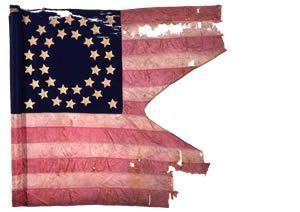Died on the Fourth of July: A Soldier’s End at Gettysburg
The closing moments of the Battle of Gettysburg proved fatal for Private Richard Youell of Co. C of the 136th New York.
“He passed unharmed through all danger until about 4 o'clock of Friday, July 3rd,” recalled Lieutenant Edward E. Sill as he described Youell’s death to his father. “He, with his comrades from our regiment, was in the advance, skirmishing, when the enemy charged on our works. He was fighting manfully when he received his fatal wound. He was struck by a rifle ball, which lodged in his bowels. When hit he dropped his gun, placed both hands upon his wound and exclaimed, "I am shot" when he turned and walked off the field. He was temporarily placed in the cellar of a brick house on the field. He was cheerful and seemed grateful for the attention shown him. As we met, he smiled, and extending his hand we bade each other farewell. I was conscious he would not survive his wound.”
Lieutenant Sill’s letter appears on the blog courtesy of the New York State Military Museum and Veterans Research Center.
 |
| Guidon flag belonging to the 136th New York Volunteer Infantry (New York State Military Museum and Veterans Research Center) |
July 29, 1863
Mr. Youlls, dear sir:
Last evening I received a letter
from my father, informing me that he had received a visit from you, and
requesting on your behalf a statement of facts concerning the death and burial
of your son. I will cheerfully do anything to assuage the grief you must feel
at the loss of so brave and faithful a soldier and son as was Richard. My
acquaintance with him began at Portage, during the formation of our Regiment in
September last. Our acquaintance soon grew to a friendship. He united in an
extraordinary degree, the manly qualities of a good soldier. He was always
ready for duty. His place was never vacant. No matter how wearisome and painful
the march, or other duty, I never heard him utter any complaint. In action he
bore himself gallantly.
He passed unharmed through all
danger until about 4 o'clock of Friday, July 3rd. He, with his
comrades from our regiment, was in the advance, skirmishing, when the enemy
charged on our works. He was fighting manfully when he received his fatal
wound. He was struck by a rifle ball, which lodged in his bowels. When hit he
dropped his gun, placed both hands upon his wound and exclaimed, "I am
shot" when he turned and walked off the field. He was temporarily placed
in the cellar of a brick house on the field. Hearing that he was there, I
immediately visited him. While here he suffered but little. He was cheerful and
seemed grateful for the attention shown him. I immediately directed a litter to
be procured and he be removed to the Hospital. As we met, he smiled, and
extending his hand we bade each other farewell. I was conscious he would not survive
his wound. At the Hospital he received all the attention and care which under
the circumstances could be given.
He lingered until the morning of
Saturday July 4th, when he died. Collecting his effects we bore him to his
narrow, soldier grave, where beside many others of his fallen comrades, he now
sleeps. If you visit Gettysburg, you will find his grave beneath an apple tree
on the west side of the Cemetery Hill field, and about half a mile south of the
town of Gettysburg. When he received his wound he was in the cornfield, in the
rear of the brick house, west of his grave. When we left, there were about
twenty graves there in a cluster. At the head of his grave we placed a board,
whereon was marked his name, Regiment Company and date of death. I think you
will have no difficulty in finding the spot. The apple tree stands about five
rods from the road, near a stone wall.
It may be gratifying to you to
know that it was the intention of his officers to promote him at the first
opportunity, for his fidelity as a soldier. Any further service which I can
render will be cheerfully given.
Edward E. Sill, First Lieutenant, Co. K, 136th
N.Y.V.











Comments
Post a Comment